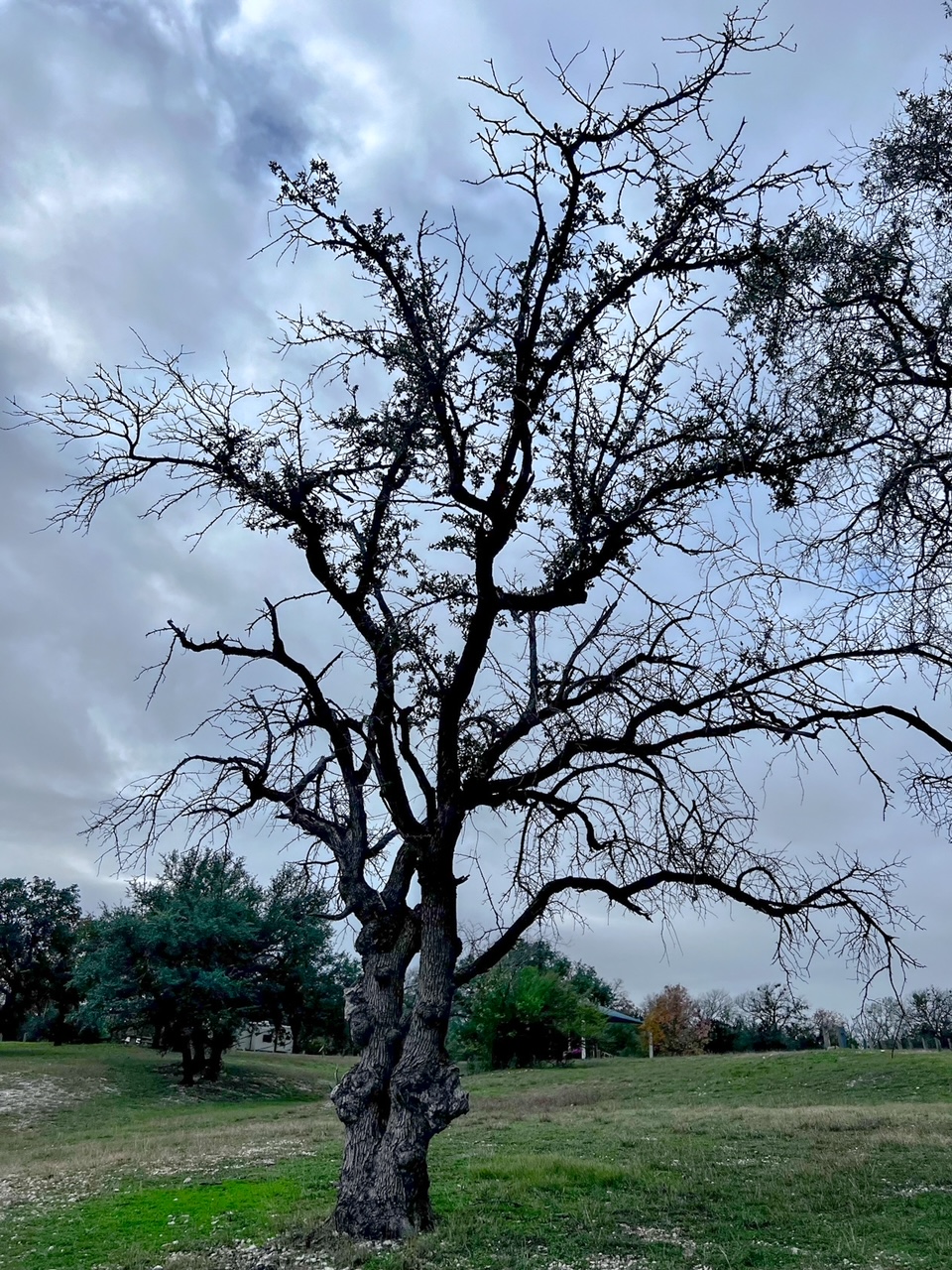This Texas Live Oak, looking sickly and wounded, having shed most of her leaves earlier than her cohorts, and stunted by comparison, somehow hangs on. For whatever reason, when I look at her, I see strength her cohorts have not had to muster and resilience they have not begun to tap. Will she survive and for how long? Perhaps she is near the end of her life, but she leaves behind images and inspiration that her more upright and undamaged siblings nearby cannot match in their relatively bland appearance. They still hold their small, ovate leaves tightly, waiting for the late winter/early spring shed. She has only handfuls left by which to help identify her species.
The Texas Live Oak has other names of which I was previously unaware. Quercus fusiformus is also called escarpment live oak, plateau live oak, and plateau oak.
Why do I prefer “escarpment live oak”?
“Escarpment” is one of those words that, in English, just sounds like what it is in such a palpable way. The scraping of the c against the a and the following plosives p and t conjure the very texture of a Texas Hill Country escarpment with its limestone, desperately clinging grasses, and scraggly shrubs. The name “Escarpment live oak” may give testimony to the sturdiness of these trees better than the more common name of Texas live oak.
The live oaks at Lake Whitney are generally healthy and run about twenty to twenty-five feet tall by my slapdash measure. They bend and bow as Live Oaks tend to do, but I do not see the huge sprawling Southern or Texas Live Oaks I have seen in Houston and its surrounding counties where water is more plentiful and soil more forgiving. As natives, they are happy here, nonetheless.
This tree, however, with its numerous burls, has seen some stuff. Due to injuries, infection, abuse from park visitors, or whatever it has been through, it has put on striking humanoid and beastlike faces in response.


Humans tend to see patterns in random assemblages of lines, shapes, and shadows: the man in the moon, the face on mars, Jesus on toast, and Mary in a rust stain on a cave wall. I am aware that I am making patterns out of random bark and burls (“gnarly bark” as a friend called it) when I describe these burls as “humanoid” or “animal-like.”
It is no less intriguing and, on some level, disturbing.
There are things in this world too “uncanny valley” for me such as robots that look too human or that run and jump like dogs. Trees that have faces fit that category.
Yet, despite some mild discomfort, this tree also reminds me of myself, of the ugliness of my wounds of grief and complex PTSD that is being shaped into something more “human.”
This tree mirrors a strength that people do not believe I have because they see me as “stuck” or stunted when, in fact, I am simply trying to grow through my wounds with minimal nutrients (support) along the way.
I too have “gnarly bark”—extra padding, wrinkles, and sagging jowls—but somehow, I will learn to embrace these in the same way this tree simply keeps surviving despite its damage.
Last Updated on March 24, 2023 by Lee Ellis





“I describe these burls as “humanoid” or “animal-like.”” That is exactly what I saw in that picture!
“I am simply trying to grow through my wounds with minimal nutrients (support) along the way.”
It is so meaningful and powerful. I swear I know more than two English words, but somehow those two words resonate with your texts and pictures.
In the main picture, the sky is grey, but as it turns out, only on the right half. On the left half, you manage to capture the texture of the clouds, and that is unbelievably beautiful.
Did you use your phone or a camera. I have been trying to capture clouds textures forever, the picture always comes out flat. The last attempt was a couple of days ago, a line that looked like a rollocoaster but made of diaphane white clouds was topping the straight lines, in vivid colors, of the early sunrise.
It was not possible for me to capture them, I took pictures of the sunrise, anyway, I might be able to see them, if the photo is manipulated in some manner.
These were all taken with my (iphone!). I probably (but won’t swear to it) punched up the contrast a little with Photoshop Express. If you’re using a cellphone, I highly recommend PSExpress. You can do a lot of post processing in the standard phone photo app but PSE gives you a little more delicate controls. Playing with factors like shadows, highlights, and contrast can really make texture pop.
Thank you so much for the recommendation!
Ugh. I must have been tired. I meant “taken with my phone”! Geez. I rarely use my “good” camera and find that except for birds or macro, the iPhone (13 pro max) really does a beautiful and intuitive job. If I had a truly great camera, (and steadier hands) I’m sure I’d feel differently.
Oh thank you so much, I’ll check that out!